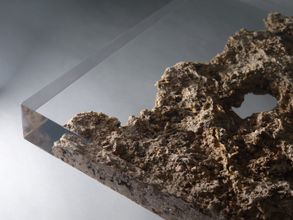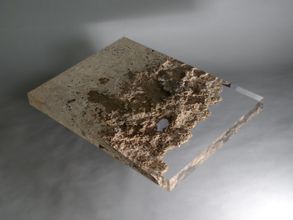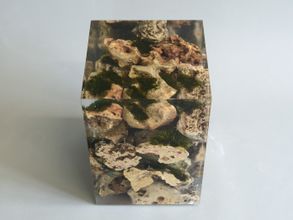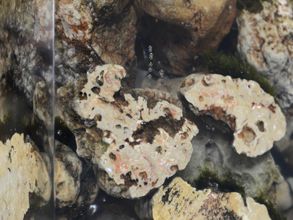Alcarol Bedrock Collection
BEDROCK COLLECTION
BEDROCK COLLECTION
An Exciting Dive Through The Intimate Geological Relationship Between Stone And Water
In geology, Bedrock is the consolidated rock at the surface of the Earth or other terrestrial planets.
“Is a mountain only a huge stone? Is a planet an enormous mountain?”
Stanislaw Lem
Anyway, Bedrock is rock “in place”, as opposed to material that has been transported from another location by weathering and erosion, so it’s the unquestionably, authentic and ancient Genius Loci of a place. Bedrock Collection aims to capture the complex relief of some Italian lands like the Dolomite Mountains, Karst regions or Sienese Hills, which are rich in forms and the result of a successful and harmonious combination of structural shapes and climatic conditions.
This unique and dynamic landscape is in constant geomorphological evolution, starting from the Miocene period, when rock layers began to emerge from the sea in which they had sedimented. Alcarol retrieved blocks of local stone from various Italian quarries, often discarded pieces due to the presence of irregular outer crust.
These stones are often partially covered with native mosses and lichens giving it a surface that captures the real vegetation of a place. In the section planes are clearly visible the different layers of geological sedimentation. Alcarol has preserved its outer “skin” and natural cavities marked by time using a resin resembling the water in which these stones lay submerged through various geological eras, freezing the present instant and endowing the pieces with new functionality and new design.
FLOATING KARST
BEDROCK COLLECTION / SIDE TABLES
Karst is a distinctive landscape shaped by the dissolving action of water on soluble rocks like the famous Dolomite’s mountains, Unesco World Heritage. The development of karst occurs whenever acidic water starts to break down the surface of bedrock near its cracks. The geological process, occurring over many thousands of years, results in unusual surface and subsurface features ranging from sinkholes,vertical shafts, disappearing streams and springs, to complex underground drainage systems and caves allowing for rapid and often turbulent water flow.
















Alcarol retrieved pieces of local karst stone partially covered with native mosses and lichens. This skin marked by time has been preserved using a water-like transparent resin, in order to recall the particular environment in which these rocks are submerged through various eras, crossed and eroded by water, and creating at the same time an unusual effect of lightness as if the stones were suspended in a floating instant.
The section planes reveal the amazing shapes and cavities generated by the water, freezing the present instant and endowing the blocks with a new and eternal functionality.
YEAR OF PRESENTATION
2018
DIMENSIONS
30 x 30 x H 45 cm
MATERIALS
- Karst stone
FLOATING KARST LAMP
BEDROCK COLLECTION / COMPLEMENTS
Karst is a distinctive landscape shaped by the dissolving action of water on soluble rocks like the famous Dolomite’s mountains, Unesco World Heritage. The development of karst occurs whenever acidic water starts to break down the surface of bedrock near its cracks. The geological process, occurring over many thousands of years, results in unusual surface and subsurface features ranging from sinkholes,vertical shafts, disappearing streams and springs, to complex underground drainage systems and caves allowing for rapid and often turbulent water flow.




Alcarol retrieved pieces of local karst stone partially covered with native mosses and lichens. This skin marked by time has been preserved using a water-like transparent resin, in order to recall the particular environment in which these rocks are submerged through various eras, crossed and eroded by water, and creating at the same time an unusual effect of lightness as if the stones were suspended in a floating instant.
The section planes reveal the amazing shapes and cavities generated by the water, freezing the present instant and endowing the blocks with a new and eternal functionality.
YEAR OF PRESENTATION
2018
DIMENSIONS
13 x 18 x H 36 cm
(Customizable Sizes, Design and Finishes)
MATERIALS
- Karst stone
RAPOLANO LOW TABLE
BEDROCK COLLECTION/ SIDE TABLES
During the Pliocene epoch, about three million years ago, those who had observed the landscape from the top of the Chianti hills, would have seen an arm of the sea, about thirty kilometers wide, extend towards South-East for at least 80 Km. A similar physiographic situation strongly influenced the constitution of the territory, forming that sea basin that acted as a formidable area of recall and accumulation of sediments carried by the water, unloading the fragments of rocks in the sea.









The subsequent erosive phenomena, mainly due to water and wind, further contributed to depict that piece of land with the appearance of a petrified stormy sea. The Italian town of Rapolano in the Sienese lands has been known since the ancient Romans who went there to take the thermal baths in its hot springs.Alcarol -in collaboration with Vaselli- retrieved pieces of eroded Rapolano Travertine rock and has preserved its cavities marked by time using a transparent resin resembling the water in which these rocks lay submerged through various eras.
Then with the progressive withdrawal of the sea from the region it was determined the overlap of rock bodies in the typical stratigraphy of clays, sandstones and conglomerates, whose deposits – however – remained influenced by the oscillations of the sea level, which, although for relatively short periods,he again came back to invade the land, alternating environments of lagoon, beach, and shallow sea.
DETAIL
- Natural Travertine surface not covered by resin on the section planes.
- Selective stone coating with matt natural effect.
DIMENSIONS
- 70 x 95 x H 28 cm
MATERIALS
- Rapolano's TRAVERTINE
YEAR OF PRESENTATION
- Atelier Bespoke _ Milan
RAPOLANO STOOLS
BEDROCK COLLECTION/ SIDE TABLES/ STOOLS
The Italian town of Rapolano in the Sienese lands has been known since the ancient Romans who went there to take the thermal baths in its hot springs, and Rapolano Travertine rock was known since the ancient Etruscan times as a building material. Rapolano Travertine is a sedimentary rock formed by the precipitation of carbonate minerals from solution in ground waters, often at the mouth of a hot spring or in a limestone cave. In the latter, it can form stalactites, stalagmites, and other speleothems.















It often has a fibrous or concentric appearance and exists in white, tan, cream-colored, and even rusty varieties that distinguish it from any other Travertine in the world.Alcarol -in collaboration with Vaselli- retrieved pieces of this eroded Travertine rock and has preserved its cavities marked by time using a transparent resin resembling the water in which these rocks lay submerged through various eras.
DIMENSIONS
30 x 30 x H 45 cm
MATERIALS
-Rapolano's Travertine -Extraclear Polished Resin -Felt Hidden At The Bottom.
DETAIL
-Natural Travertine surface not covered by resin on the section planes. -Selective stone coating with matt natural effect.
YEAR OF PRESENTATION
- Atelier Bespoke _ Milan
DOLOMYTH STOOL
BEDROCK COLLECTION/ SIDE TABLES/ STOOLS
Alcarol retrieved blocks of local stone from an abandoned quarry. This stone is partially covered with native mosses and lichens giving it a surface that captures the geographical maps of the Dolomite’s mountains. In the vertical section planes are clearly visible the different layers of geological sedimentation, with shades ranging from antique pink to gray. The top surface of the blocks is the rough and wrinkled natural surface of the rock, unsanded and not worked by man.





Alcarol has preserved this “skin” marked by time using a resin resembling the water in which these stones lay submerged through various geological eras, freezing the present instant and endowing the blocks with new functionality and new design.
YEAR OF PRESENTATION :2014
- Mint Gallery _ London
DIMENSIONS
- 30 x 30 x H 45 cm
MATERIALS
- Dolomite ROCK
DETAIL
Natural Stone surface not covered by resin on the section planes. Selective stone coating with matt natural effect.
DOLOMYTH VASE
BEDROCK COLLECTION/ COMPLEMENTS
Dolomyth Vase is derived from blocks of local stone recovered in an abandoned quarry of Dolomite Mountains. In the vertical section planes are clearly visible the different layers of geological sedimentation, with shades ranging from antique pink to grey, typical of dolomite rocks.







On the base the extraclear resin, resembling the water in which these stones lay submerged through various geological eras, preserves the rough and wrinkled natural surface of the rock, creating the effect of suspending the stone in the void and giving it an unusual lightness. At the top, there is a small removable glass container in which to place little plants and flowers with water.
DETAIL
- Natural Stone surface not covered by resin on the section planes.
- Selective stone coating with matt natural effect.
YEAR OF PRESENTATION : 2018
- FuoriSalone 2018 _ Milan
DIMENSIONS
- 7 x 7 x H 32 cm
MATERIALS
- Dolomite ROCK
KARST STOOL
BEDROCK COLLECTION/ SIDE TABLES/ STOOLS
Karst is a distinctive landscape shaped by the dissolving action of water on soluble rocks like the famous Dolomite’s mountains, Unesco World Heritage. The development of karst occurs whenever acidic water starts to break down the surface of bedrock near its cracks. The geological process, occurring over many thousands of years, results in unusual surface and subsurface features ranging from sinkholes,vertical shafts, disappearing streams and springs, to complex underground drainage systems and caves allowing for rapid and often turbulent water flow.








Alcarol retrieved pieces of local karst stone partially covered with native mosses and lichens. This skin marked by time has been preserved using a water-like transparent resin, in order to recall the particular environment in which these rocks are submerged through various eras, crossed and eroded by water, and creating at the same time an unusual effect of lightness as if the stones were suspended in a floating instant.
The section planes reveal the amazing shapes and cavities generated by the water, freezing the present instant and endowing the blocks with a new and eternal functionality.
YEAR OF PRESENTATION : 2015
- Mint Gallery _ London
DIMENSIONS
- 30 x 30 x H 45 cm
MATERIALS
- Karst stone
DESIGNER
ELEONORA DAL FARRA
Eleonora Dal Farra – conservator – was born in the Dolomite mountains in 1986. In 2005 she moved to Venice in pursuit of her passion for art and graduated at the Academy of Fine Arts. In 2007 she collaborated with the artist Odili Donald Odita at the 52nd International Art Exhibition, deepening the perceptual phenomena related to shape and color.
In 2009 he graduated in Artistic Restoration, undertaking collaborations of varying services in a range of site and restoration workshops throughout Italy. Eleonora is always attending courses, symposiums and artistic events, participating and organizing art exhibitions. In her speeches and her creations she always tries to marry heritage and craftsmanship with a more free and uninhibited creativity, investigating and using the most ancient manufacturing techniques and inserting them in contemporary processes.
ANDREA FORTI
Andrea Forti – architect – was born in the Dolomite mountains in 1981. Then he moved to Venice, where he graduated in 2005 in Architecture at IUAV. Immediately undertaking collaborations with various architects and furniture craftsmen as designer and prototypist, the simplicity and rationality that guide Andrea in projects is artistic and crafting influences which drive a strong emotional charge in his work.
During the Lagoon residency, he cultivated his passion for various forms of artistic expression, while curating very personal experimentation. Peacefully eclectic, unfaithful to genres, techniques and styles, he has participated in various symposiums and artistic events with a series of solo and group exhibitions of painting, sculpture and installation. Among the materials mainly used in his work wood emerges, always loved and revered, now carved with traditional techniques, then worked through experimental procedures.



